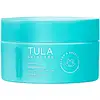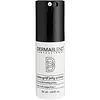What's inside
What's inside
 Key Ingredients
Key Ingredients

 Benefits
Benefits

 Concerns
Concerns

 Ingredients Side-by-side
Ingredients Side-by-side

Water
Skin ConditioningSodium Acrylates Crosspolymer-2
AbsorbentButylene Glycol
HumectantDipropylene Glycol
HumectantGlycerin
Humectant1,2-Hexanediol
Skin ConditioningPEG-40 Hydrogenated Castor Oil
EmulsifyingCaprylyl Glycol
EmollientCarbomer
Emulsion StabilisingTromethamine
BufferingEthylhexylglycerin
Skin ConditioningCitrus Junos Seed Oil
EmollientMelia Azadirachta Leaf Extract
Skin ConditioningCitrus Limon Peel Oil
MaskingCitrus Junos Peel Oil
AstringentMelia Azadirachta Flower Extract
Skin ConditioningCurcuma Longa Root Extract
MaskingBrassica Rapa Root Extract
Skin ConditioningOcimum Sanctum Leaf Extract
Skin ConditioningSilica
AbrasiveLactococcus Ferment Lysate
Skin ConditioningCitrus Aurantium Dulcis Peel Oil
MaskingCitrus Aurantium Bergamia Fruit Oil
MaskingEpilobium Angustifolium Flower/Leaf/Stem Extract
Skin ConditioningLactic Acid
BufferingCorallina Officinalis Extract
Skin ConditioningSodium Chloride
MaskingLepidium Meyenii Root Extract
Skin ConditioningCitrus Junos Seed Extract
AntioxidantSodium Benzoate
MaskingCaprylic/Capric Triglyceride
MaskingVaccinium Macrocarpon Fruit Extract
AstringentPhenoxyethanol
PreservativeMethicone
EmollientTocopherol
AntioxidantSodium Metabisulfite
AntioxidantLimonene
PerfumingLinalool
PerfumingCitral
PerfumingWater, Sodium Acrylates Crosspolymer-2, Butylene Glycol, Dipropylene Glycol, Glycerin, 1,2-Hexanediol, PEG-40 Hydrogenated Castor Oil, Caprylyl Glycol, Carbomer, Tromethamine, Ethylhexylglycerin, Citrus Junos Seed Oil, Melia Azadirachta Leaf Extract, Citrus Limon Peel Oil, Citrus Junos Peel Oil, Melia Azadirachta Flower Extract, Curcuma Longa Root Extract, Brassica Rapa Root Extract, Ocimum Sanctum Leaf Extract, Silica, Lactococcus Ferment Lysate, Citrus Aurantium Dulcis Peel Oil, Citrus Aurantium Bergamia Fruit Oil, Epilobium Angustifolium Flower/Leaf/Stem Extract, Lactic Acid, Corallina Officinalis Extract, Sodium Chloride, Lepidium Meyenii Root Extract, Citrus Junos Seed Extract, Sodium Benzoate, Caprylic/Capric Triglyceride, Vaccinium Macrocarpon Fruit Extract, Phenoxyethanol, Methicone, Tocopherol, Sodium Metabisulfite, Limonene, Linalool, Citral
Ingredients Explained
These ingredients are found in both products.
Ingredients higher up in an ingredient list are typically present in a larger amount.
1,2-Hexanediol is a synthetic liquid and another multi-functional powerhouse.
It is a:
- Humectant, drawing moisture into the skin
- Emollient, helping to soften skin
- Solvent, dispersing and stabilizing formulas
- Preservative booster, enhancing the antimicrobial activity of other preservatives
Dipropylene Glycol is a synthetically created humectant, stabilizer, and solvent.
This ingredient helps:
Dipropylene glycol is technically an alcohol, but it belongs to the glycol family (often considered part of the ‘good’ alcohols). This means it is hydrating and gentle on skin unlike drying solvent alcohols like denatured alcohol.
As a masking agent, Dipropylene Glycol can be used to cover the smell of other ingredients. However, it does not have a scent.
Studies show Dipropylene Glycol is considered safe to use in skincare.
Learn more about Dipropylene GlycolGlycerin is already naturally found in your skin. It helps moisturize and protect your skin.
A study from 2016 found glycerin to be more effective as a humectant than AHAs and hyaluronic acid.
As a humectant, it helps the skin stay hydrated by pulling moisture to your skin. The low molecular weight of glycerin allows it to pull moisture into the deeper layers of your skin.
Hydrated skin improves your skin barrier; Your skin barrier helps protect against irritants and bacteria.
Glycerin has also been found to have antimicrobial and antiviral properties. Due to these properties, glycerin is often used in wound and burn treatments.
In cosmetics, glycerin is usually derived from plants such as soybean or palm. However, it can also be sourced from animals, such as tallow or animal fat.
This ingredient is organic, colorless, odorless, and non-toxic.
Glycerin is the name for this ingredient in American English. British English uses Glycerol/Glycerine.
Learn more about GlycerinWater. It's the most common cosmetic ingredient of all. You'll usually see it at the top of ingredient lists, meaning that it makes up the largest part of the product.
So why is it so popular? Water most often acts as a solvent - this means that it helps dissolve other ingredients into the formulation.
You'll also recognize water as that liquid we all need to stay alive. If you see this, drink a glass of water. Stay hydrated!
Learn more about Water